As far back as 2014, when Fiona Raven and I began working on the cover design for Brainwash, I entertained the idea of replacing the iStock images of Darcy and Bullet with artist-drawn ones, with the notion that one day I might decide to trademark them. read more…
Hardwired
new thriller series
Europe 2013: Toledo, Spain – Part 2
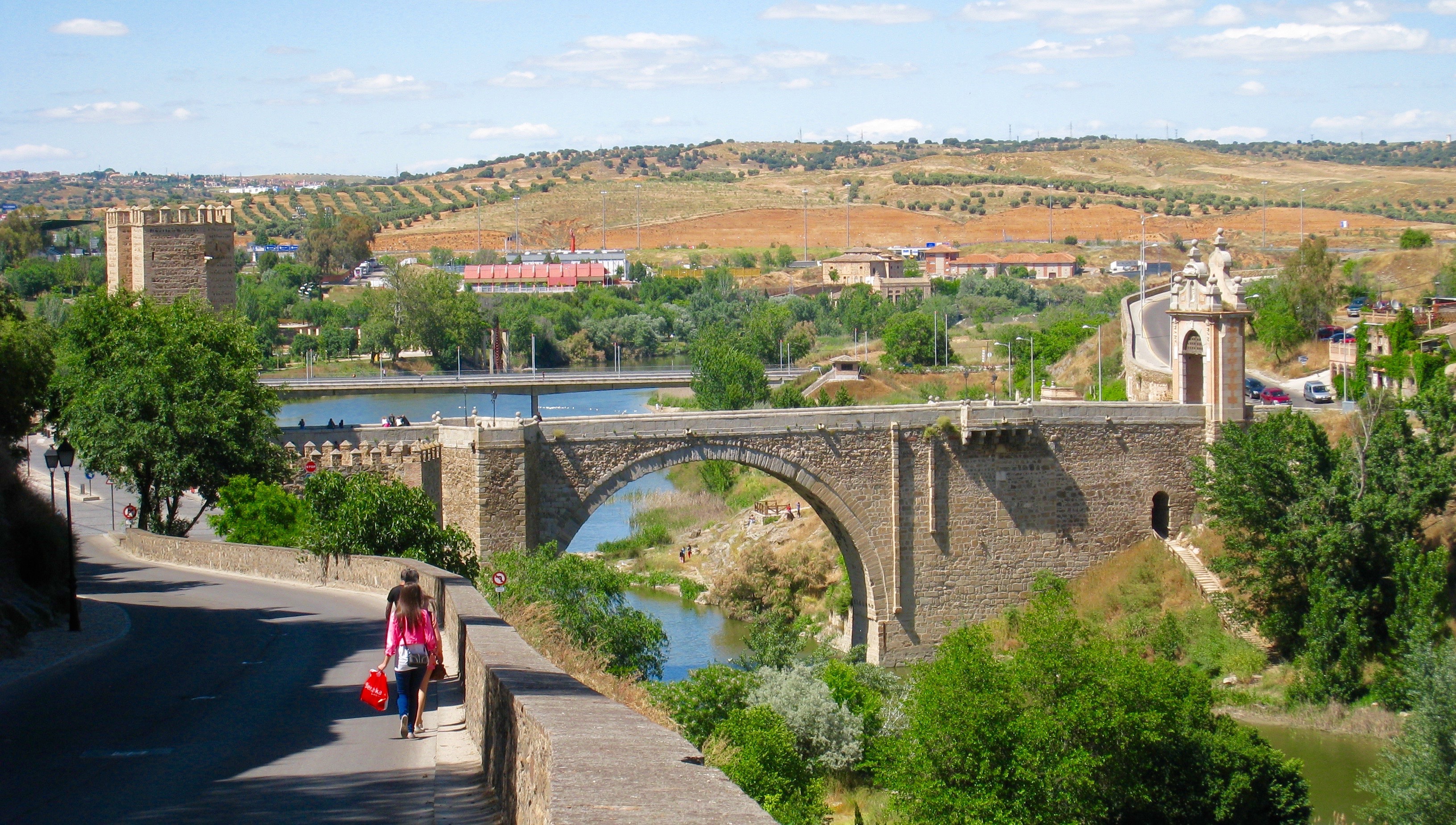
Last week we visited Alcázar. Picking up from there, we left the castle and made our way to Toledo’s cathedral. The formal name of the French Gothic church is Santa Iglesia Catedral Primada de Toledo. Construction on the white limestone structure began in 1227 on the site of a former mosque. The opulent, shimmering, gold interior is jaw-dropping: it’s laden with elaborate wrought iron work, lavish wood carvings, 750 five-hundred-year-old stained glass windows, and a spectacular gold high altar, not to mention eighteen El Greco masterpieces.
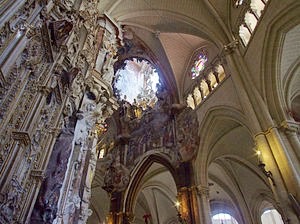
El Transparente, a Baroque altarpiece
All around me tourists uttered the same word: “Wow.” The initial design had five naves and eighty-eight columns and measured 390 feet long by 196 feet wide. Over the centuries additions have been made to the original building. In the fourteenth century San Blas Chapel and a cloister were added, and construction on the towering altar in the main chapel began. It took six years to complete, and many famous sculptors worked on the five-story gold filigree structure. During the fifteenth century vaults were added and another chapel, for a total of seven today. But the most moving and stunning feature in the cathedral was El Transparente, a Baroque altarpiece illuminated by a large skylight cut high in the ambulatory behind the high altar. A second hole cut into the back of the altarpiece itself allows sunlight to strike the tabernacle. The illumination is dazzling when the sun shines from the east, giving the impression that the whole altar is rising to heaven.
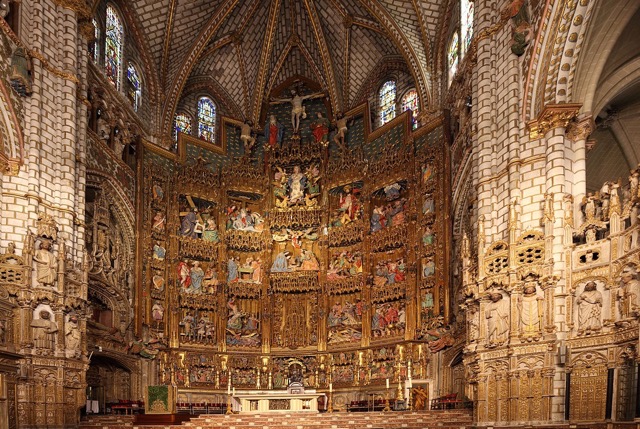
Catedral de Toledo, Spain – Large skylight cut high in the ambulatory behind the high altar
We stepped outside to blinding sunlight and made our way through the picturesque narrow streets to Sinagoga de Santa Maria la Blanca, the synagogue of “St. Mary the White,” The 1203 house of worship was designed and decorated by Mudéjar architects. The architectural style was a synthesis of techniques resulting from Muslim and Christian cultures living side by side and emerged during the twelfth century. The dominant characteristics are elaborate tile work, brickwork, wood and plaster carvings, and ornamental metals. To dress up walls and floors, Mudéjar architects used complicated tile patterns. Long after the Muslims were no longer employed as builders in Spain, their distinctive elements continued to be incorporated into Spanish architecture. Inside the synagogue the Moorish influence is obvious in lovely white horseshoe arches, capitals carved with vegetal motifs, and the contrasting dark red floors with decorative tiles. (In architecture, a capital is a “head,” the topmost section of a column or pilaster.) The synagogue has been used as a carpenter’s workshop, a store, a barracks, and a refuge for former prostitutes. Beautifully restored, today it is a museum.
Our next stop was El Tránsito Synagogue, a private family synagogue known for its rich polychrome stucco work, multi-foil arches, and a massive Mudéjar paneled ceiling with Arabic inscriptions intertwined in the floral patterns of the stucco panels. After the expulsion of the Jews from Toledo in 1492, the building was converted into a church.
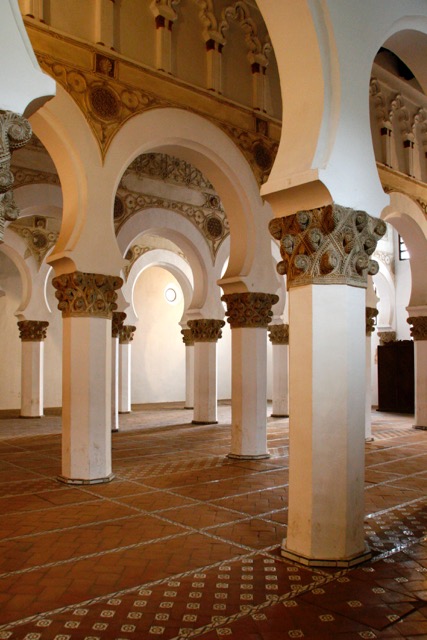
Sinagoga de Santa Maria la Blanca, Toledo, Spain
We lunched on tapas at Mesón La Orza before we set out for the El Greco Museum, only to find it closed. We had no information about whether or not it would open that day, so we walked on to the Monasterio de San Juan de Los Reyes. The structure was built by Catholic monarchs King Ferdinand II and Queen Isabella I to commemorate their victory over the army of Alfonso V of Portugal in 1476, and they also planned to house their mausoleum there. However, after the reconquest of Granada in 1492, the Catholic monarchs chose to be buried in Capilla Real in Granada. The two-story Gothic monastery with its Plateresque stonework, a larch wood ceiling painted with the motifs and the coats of arms of the monarchs, and the peaceful cloister and garden were definitely worth the visit. I would have liked to linger a bit longer, but we had two more stops to make and had to hurry along to catch a train back to Madrid. But before we left, Dave had to show me something on the exterior of the monastery. Chains hung from on high, the remnants of leg irons worn by the Christians imprisoned by the Muslims. During the reconquest, the prisoners were freed, and the chains were hung on the monastery in 1494 to symbolize the triumph of Christianity.
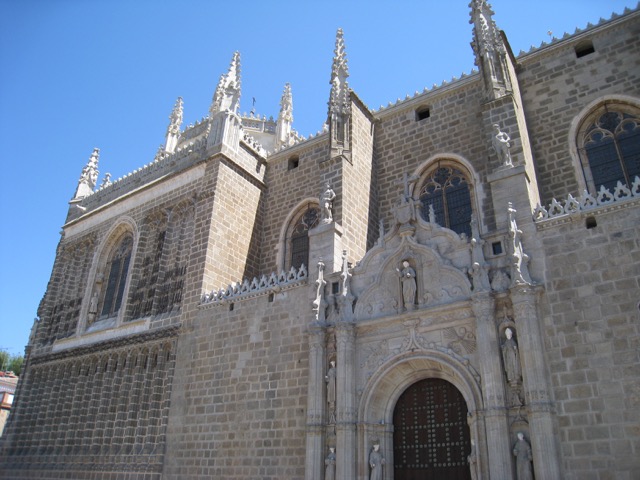
Monasterio de San Juan de Los Reyes, Toledo, Spain
With only two hours left for sightseeing and still much to see, we both agreed we should have considered at least a two-day stay in Toledo and noted this for a future visit. Not rushing but not dawdling either, we headed toward the Puente de San Martín. Constructed in the late fourteenth century to provide access to the old town from the west, the bridge has five arches, heavy fortification with towers, and an impressive span of just over 130 feet. At that time, very few bridges in the world had reached that length. It complements the older Puente de Alcántara, which links the city to the east.
Our next stop was Puerta de Bisagra, the main gate to the old city of Toledo, a majestic stone gate built in the tenth century in the time of the taifa of Toledo. The taifa was a Muslim medieval kingdom located in central Spain in 1035 that endured until the Christian conquest in 1085. The gateway is actually two gates, the old one built by the Moors between the sixth and seventh centuries, and a new gate built in the sixteenth century. After photo snapping and a time check, we pressed on to our next destination.
Mezquita del Cristo de la Luz dates back to 999 and was built as a mosque known as Bab al-Mardum. It is the only surviving mosque of ten that once stood in Toledo. It has a square footprint that measures roughly twenty-six by twenty-nine feet. The facade is brick and decorated with a series of arches. The interior has open brick latticework and an arcade of blind horseshoe arches that support nine ribbed vaults, all of which have a unique geometric design. In 1186 when the mosque was converted into a chapel, a transept and a Mudéjar-style apse were added. The chapel derives its name from legend. When King Alfonso VI rode into Toledo in victory in 1085, he discovered that a candle, which had burned continuously behind the brick masonry for three and a half centuries of Muslim rule, was illuminating a statue of Christ concealed within the brick wall to prevent profanation.
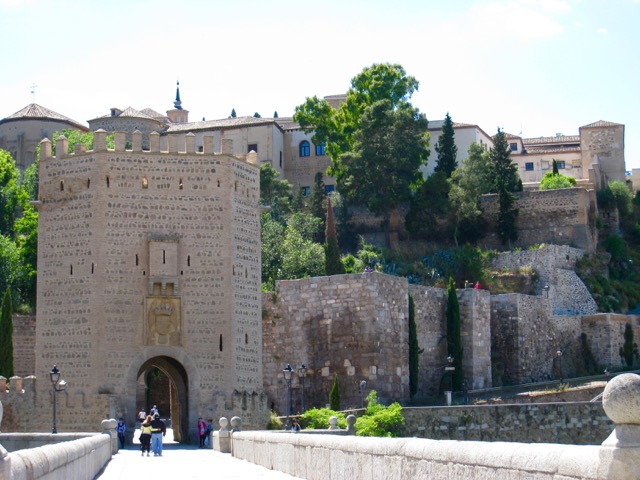
Puente de Alcántara, Toledo, Spain
Mindful of the time, Dave and I threaded our way through the quaint Toledo streets toward the Puente de Alcántara, an arched stone bridge built between 104 and 106 to span the Tagus River. So far we had avoided getting lost in Toledo, but that soon changed. The street we were on came to an abrupt end, and we had to loop back up the steep incline. Along our way a British couple stopped us to ask for directions. We really couldn’t help them, except to say that this street was not the way to the bridge. They too were in a hurry to reach the train station. “So let’s team up and rally on,” they said, and that’s precisely what we did until we bumped into a local. She gave us excellent directions, but not ones we wanted to hear. We had to hike another steep hill. We crested the rise only to discover that the bridge was nowhere in sight. We still had a ways to go. Eventually, the bridge came into view, and the four of us let out loud sighs. We finally entered the station and queued up. Neither we nor the British couple had purchased return tickets, and we were darn lucky to get the last four seats on the 5:00 p.m. train. The next available departure with any empty seats was at 9:00 p.m.
We arrived back at the Westin in time to shower and change for dinner at Lieu Restaurante for what would be a fabulous meal prepared by chef Daniele Scelza. The restaurant offered two prix fixe menus. I ordered one and Dave the other, along with the wine pairings. The meal began with test-tube cocktails and chorizo madeleines for two—gratis—followed by a transparent tomato ravioli with parmesan cream and basil for me, and for Dave a zucchini carpaccio: paper-thin slices of zucchini with a tangy citrus and herb drizzle. Next, I had an aerated gazpacho and Dave a potato-bacon pie with escargot in a beef sauce. So far everything had been superb, and we couldn’t wait for our mains—Dave had the lamb saddle with creamed sweet potatoes, and I chose black cod with olive oil, basil, tomato confit, and pumpkin puree. By the time dessert arrived, I had run out of superlatives. We shared an order of creamy chocolate with olive oil, brownies, and tiles of red wine granita; and an order of berries, cassis sorbet, and ginger chips, topped with a champagne foam. Both were palate-pleasing delights. A meal to remember, but unfortunately, from what I’ve read on the Internet, the restaurant has permanently closed.
Europe 2013: The Guggenheim – Bilbao, Spain
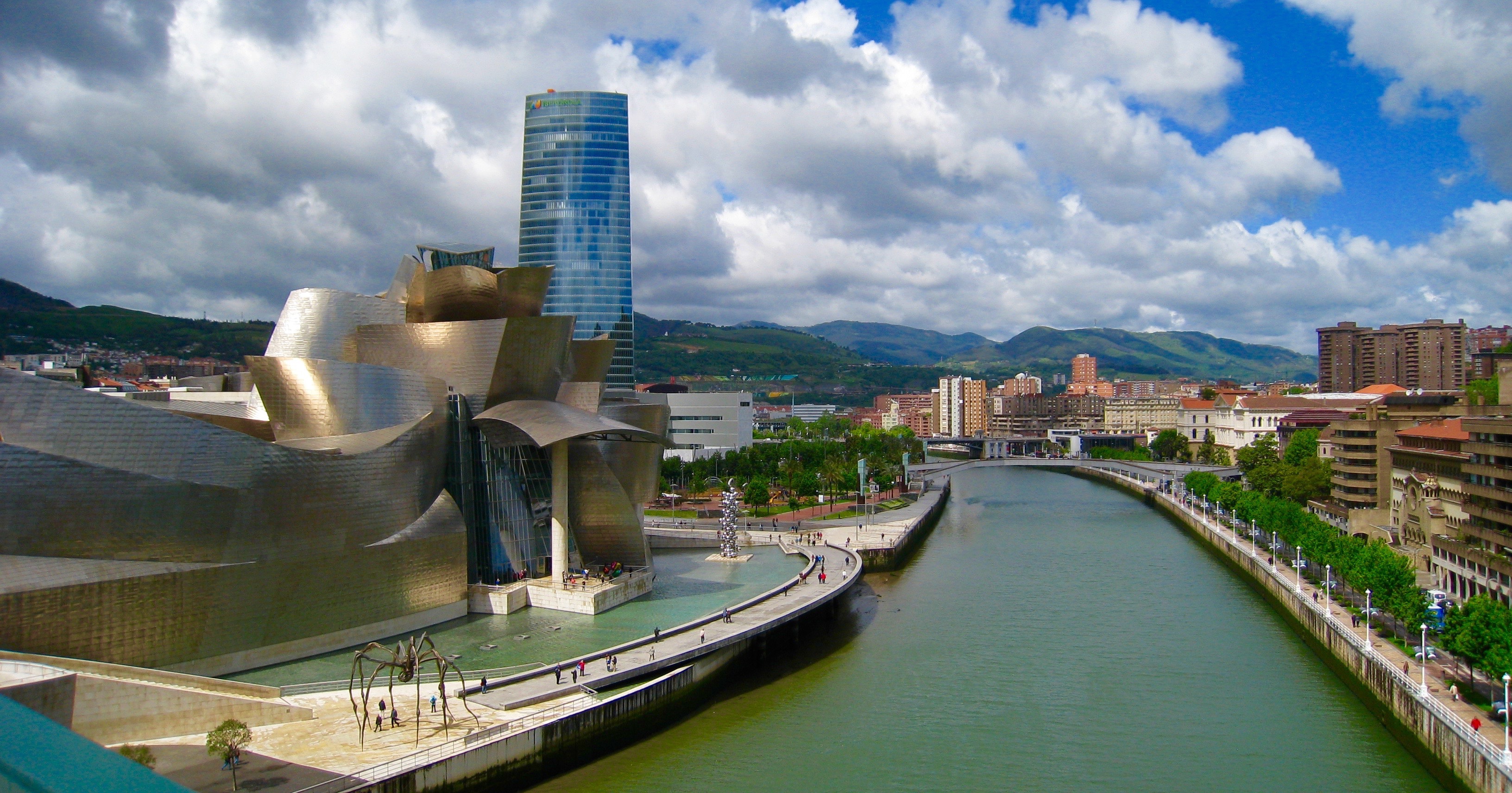
Another cloudy morning greeted us as we went downstairs for breakfast at the Albatros. We wanted to eat, then get a head start on the drive to Bilbao to visit the Guggenheim Museum, which I had wanted to visit since I’d seen Dancing House, also known as the Fred and Ginger house, in Prague, Czech Republic. I wasn’t as interested in the exhibits as much as the architecture of the building itself. I hoped the weather would hold so I could take some decent pictures. We filed into the dining room along with the French tour group, also up early but for an outing into the Spanish countryside. A pleasant and exuberant group, they asked if we would join them for breakfast. We politely declined and pointed out that their tables were reserved for their gathering only.
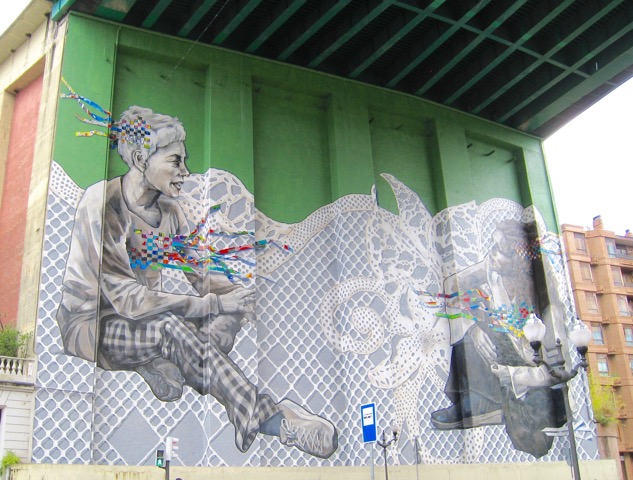
Mural Under Puente de la Salve
Rain pelted us during the hour-and-a-half drive from Suances to Bilbao, but despite the inclement weather we enjoyed the trip, especially when the road hugged the coastline along the Bay of Biscay. The rain and the terrain reminded me of the Florence, Oregon coastline. During my college days at the University of Oregon, I used to spend hours strolling the uninterrupted miles of beaches that stretched along the dazzling Pacific Ocean.
I knew from research that a thriving cultural sector is an essential part of any great city, just as expanses of greenbelts, which limit sprawl, are important to the health of urban dwellers and help them feel more connected to nature. But for me, the star-quality draw in Bilbao had nothing to do with green spaces. My sights were set on finally seeing Frank Gehry’s shimmering titanium, limestone, and glass attraction—the Guggenheim.
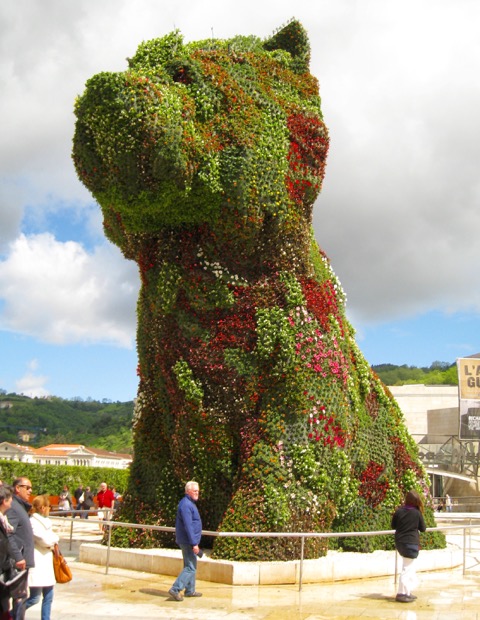
Puppy, by Jeff Koons
Prior to my visit to Bilbao, I had read an article about the “Bilbao Effect,” or “the Guggenheim Effect,” as the locals refer to it. By 1980, Bilbao, the fourth largest city in Spain, was decimated by the collapse of its steel and shipbuilding industries, its factories shuttered and its port in disrepair. After Spain joined the EU, the Basque authorities embarked on an ambitious revitalization program. They hired expensive architects to design a new airport, a metro system, and a footbridge, Zubizuri, designed by the neofuturistic architect Santiago Calatrava Valls. But the city’s biggest achievement was convincing Solomon R. Guggenheim to build a branch of the legendary Guggenheim Museum in Bilbao. For the project, they hired Frank Gehry. Critics referred to Gehry’s design as “mercurial brilliance.” The museum is the centerpiece of the Bilbao Art District.
Five years after construction, Bilbao estimated that the museum’s impact on the economy at around $168 million, more than the cost of construction of the building, which came in on budget at $89 million. In 2012, more than one million people visited the world-class museum, half of them from abroad. Bilbao has become the model for attracting investment, brands, tourism, and cultural energy through a historic cultural institution, which has transformed a struggling post-industrial city into a worldwide cultural power.
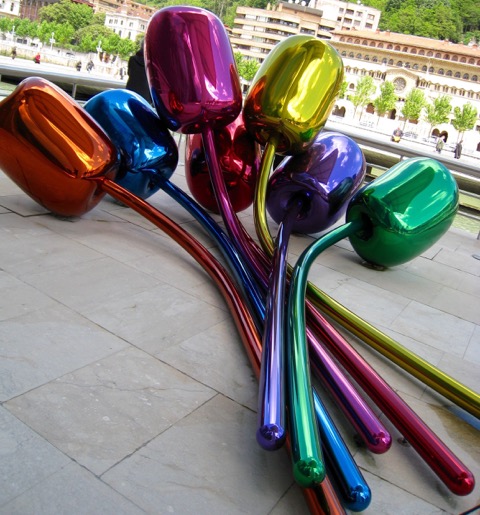
Tulips, by Jeff Koons
As we exited the motorway and threaded our way through Bilbao’s traffic-congested streets, the skies began to clear. We found a parking spot close to the Guggenheim and hopped out. Since it was still too overcast for picture taking, we decided to tour the museum first and snap photos later. I was in awe from the moment I laid eyes on Gehry’s building as we approached it from the massive steel Puente de la Salve, which crosses over the Nervión River.
At first, I had difficulty keeping my mind on the exhibits, eager for the sun to appear so I could shoot the exterior of the museum, but the significance of the exhibition, L’art en guerre, France 1938–1947: From Picasso to Dubuffet, soon grabbed and held my attention as I toured it. The exhibit had just closed in Paris and opened at the Guggenheim. We spent two somber hours working our way through the war and persecution exhibits, a solemn reminder of the horrors of the war and the genocide carried out because of hatred and fear of certain peoples and religions.
Jed Perl’s article in the New Republic is an accurate critique of the exhibition. Following is an excerpt from his article; a link to it appears at the end of this blog post.
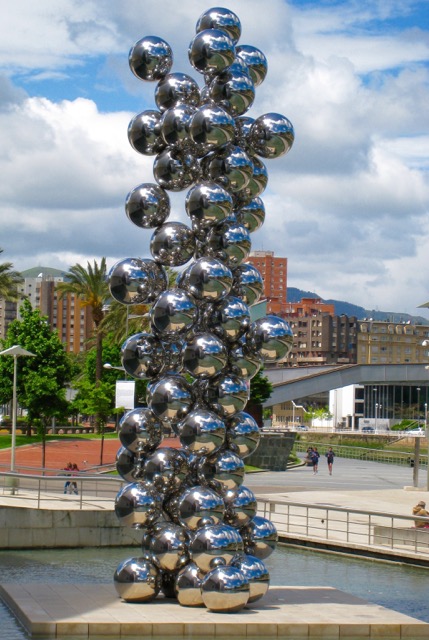
Reflectorama, by Anish Kapoor
The German occupation of Paris precipitated an extraordinary confrontation between the city where modern art was born and the regime that was determined to shatter modernity. The juxtapositions in this exhibition are harrowing. We are asked to take in both the luxuriantly sensuous visions of Henri Matisse and Pierre Bonnard, living in relative safety in Vichy France, and the stark, hardscrabble images done in detention camps by Charlotte Salomon, Otto Freundlich, and Felix Nussbaum, who would soon perish in the German death machine. If it is a story in which the moral giants are outnumbered by the moral pygmies, it is also a story that raises the gravest questions about the morality of art and the artist’s obligation to society.
Between 1939 and 1942, Camp des Milles, housed in a former brick factory, was an internment camp for political dissidents, artists, and intellectuals. After the summer of 1942, and the Nazi plan for the “final solution,” it became the holding site for almost ten thousand Jews awaiting deportation for extermination at Auschwitz. Having been stripped of their freedom and dignity, the detainees quickly organized themselves in order to survive the miserable living conditions. The painters, sculptors, writers, actors, and musicians interned at Camp des Milles had to be endlessly inventive in devising ways to ward off boredom and lift their spirits. Aside from writing and live theatrical and musical shows, over three hundred paintings and drawings are thought to have originated there. Among the “undesirables” held at the camp were Nobel Prize-winning physician Otto Fritz Meyerhof, Max Ernst, Golo Mann, Robert Liebknecht, and German author Lion Feuchtwanger, who escaped to the United States and described his experiences in the camp in his 1941 memoir, The Devil In France – My Encounter With Him In The Summer Of 1940.
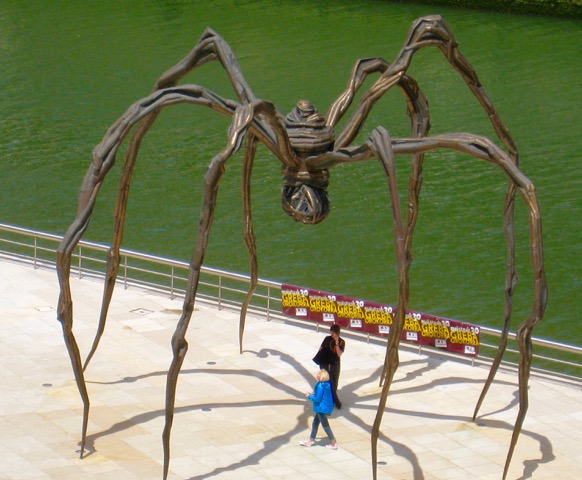
Maman, by Louise Bourgeois
Still discussing the war exhibit, Dave and I gravitated toward the Guggenheim café for a sweet and an espresso. Afterwards, we wandered the museum shop, made a few purchases, and returned to the soaring atrium with its pine, glass, and steel curves uncurling high above us. Lured outside by artist Jeff Koons’s work Tulips from his Celebration series, I snapped off several shots of his bouquet of mirror-polished stainless steel balloon flowers. I wished I had an arrangement of such beauty for my own yard. Also impressive is Louise Bourgeois’s tribute to her mother, the mammoth Maman, a nine-meter-tall bronze spider that suggests both protector and predator and embodies both strength and fragility. From the spider, I gravitated back to the tulips and on to a sculpture of cascading balls, Reflectorama, designed by the artist Anish Kapoor. And definitely original are Fire Fountain by deceased French artist Yves Klein, best seen at night as the photo insert shows, and Fujiko Nakaya’s Fog Bridge, in which steam floats out from under the Salve Bridge every hour. We circled back to the front of the museum and took several pictures of Jeff Koons’s giant, canine-topiary Puppy, one of the first works acquired by the curators. You can’t miss the forty-foot tall, flower-covered West Highland white terrier that isn’t white as you approach the Guggenheim from the Puente de la Salve. Under the bridge is a stunning mural (see photo). Everywhere you look in the Bilbao Art District, you are greeted with visual beauty.
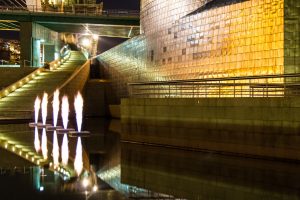
A short walk from the Guggenheim is Calatrava’s Zubizuri, Basque for “white bridge.” The design consists of a curved walkway, which is supported by steel suspension cables from an overhead arch; the deck consists of translucent glass bricks. Access ramps and stairways are located on both banks. I could easily have spent hours taking more photographs, but bad weather started to close in. Thankful for the photos snapped, we walked back across the Salve Bridge to our rental car. We tossed our drizzle-soaked Windbreakers into the backseat and motored out of Bilbao, bound for Suances.
That night, we ate at El Fanal. The establishment is owned by an Australian who is married to a Spaniard. He tends the restaurant, and she cooks. When we entered we were immediately greeted by the owner, who was friendly and outgoing. We sat at the bar and sipped a glass of wine while he talked about Australia, what we must see if we visited, and what had brought him to Suances. He showed us to our table and for starters recommended the grilled octopus. Perfection. The special of the day was a whole grilled turbot with smoky, spiced potatoes. Excellent. We also gave the nod to his wine suggestion, a Don Olegario Albariño 2012 that paired well with our seafood. For dessert, a homemade flan, something I will never turn down. Our flan arrived along with two glasses of a Spanish sherry “on the house,” a pleasant way to end a great meal in a relaxing atmosphere. Again, we had eaten too early for most Spanish diners and were alone in El Fanal until we finished our sherry. On our way out, we noticed most of the restaurant’s seats had filled.
“When the Surrealists Met the Nazis: Picasso, Paris, and modern art in Vichy France” by Jed Perl. The article can be read in its entirety.

